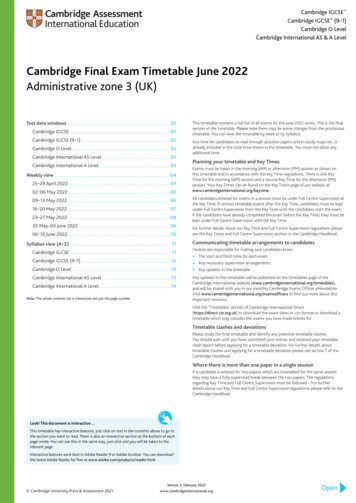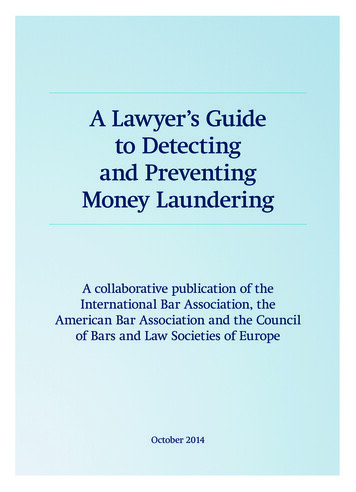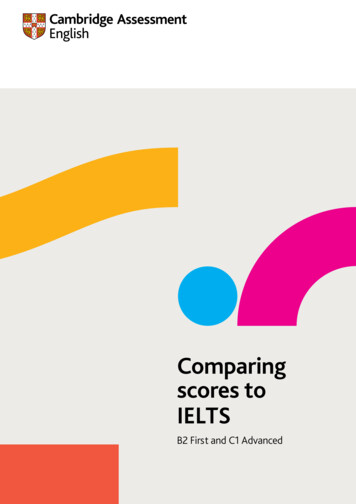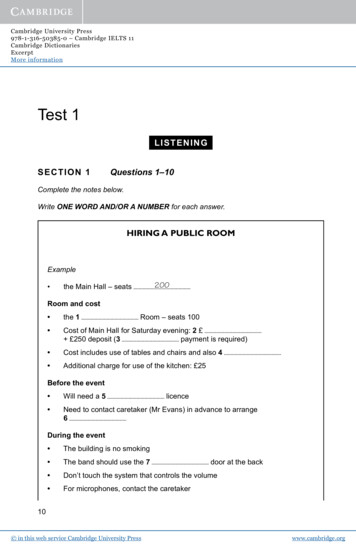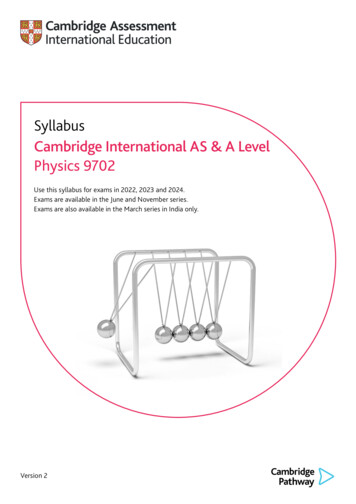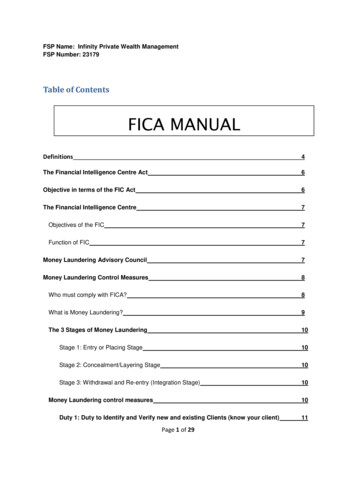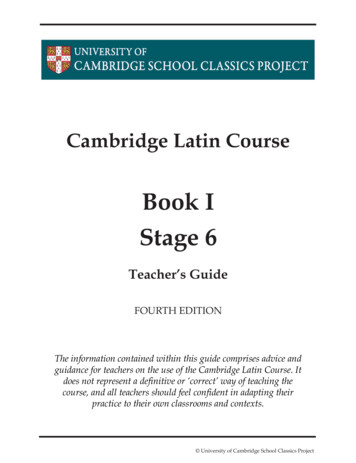
Transcription
Cambridge Latin CourseBook IStage 6Teacher’s GuideFOURTH EDITIONThe information contained within this guide comprises advice andguidance for teachers on the use of the Cambridge Latin Course. Itdoes not represent a definitive or ‘correct’ way of teaching thecourse, and all teachers should feel confident in adapting theirpractice to their own classrooms and contexts. University of Cambridge School Classics Project
Faculty of Education,184 Hills Road,CambridgeCB2 8PQThis book, an outcome of work jointly commissioned by the Schools Councilbefore its closure and the Cambridge School Classics Project and is publishedwith the kind permission of the Department for Education and CambridgeUniversity Press. University of Cambridge School Classics ProjectIn the case of this publication the CSCP is waiving normal copyrightprovisions in that copies of this material may be made free of charge andwithout specific permission so long as they are for educational and notcommercial use. Any material that is used should be attributed to the CSCPclearly and prominently.First published 1970Second edition 1982Third edition 1999This edition 2019Produced for digital publication via www.cambridgescp.comThe CSCP has no responsibility for the persistence or accuracy of URLs forexternal or third-party internet websites referred to in this publication, anddoes not guarantee that any content on such websites is, or will remain,accurate or appropriate. Information regarding prices, travel timetables andother factual information given in this work is correct atthe time of first printing but Cambridge University Press does not guaranteethe accuracy of such information thereafter.Layout by Newton Harris Design PartnershipIllustrations by Kathy Baxendale University of Cambridge School Classics Project
STAGE 6 FēlīxCulturalbackgroundStory lineSlaves andfreedmen.After witnessing a fightin the forum, Clemensbumps into one ofCaecilius’ freedmen,Felix, and takes himhome. Caecilius andMetella invite him fordinner and recall theincident which earnedFelix his freedom.Main languagefeaturesImperfect andperfect (vstems) in 3rdperson singularand plural.erat and erant.Focus ofexercises1 Story withcomprehensionquestions.2 Agreement ofnominativesingular andplural withverb.Opening page (p. 69)Illustration. Relief probably showing manumission ceremony. The magistrate standsholding the rod with which he has freed two former slaves. The conical felt cap (pilleus)which they are wearing is a mark of their new status as freedmen. The standing freedmanappears to be shaking hands with his master, whose figure has been lost from the righthand side of the relief; the other one is kneeling to him in gratitude (Morlanwelz, Belgium,Musée royale de Mariemont).Model sentences (pp. 70–1)New language feature. Introduction of two past tenses, perfect and imperfect, in the 3rdperson. In this Stage, the perfect tense has only the form in v, e.g. clāmāvit. Theimperfects erat and erant are also introduced.New vocabulary. timēbat, superāvit, pulsāvit (punched).First reading. Students may ask about the new endings. There is no signal in the text toindicate the change to past time, so you need to give an explicit lead, e.g.:Sentence 1. What were the slaves doing?In English, as in Latin, it is characteristic for the imperfect to be used to describe asituation, and the perfect to represent a momentary happening. The pairs of sentenceshighlight the contrast between the situation and the action which interrupts it, e.g. ‘Theslaves were walking when the dog barked.’ See the Independent Learning Manual Stage 6 fora cartoon showing the difference between the present and two past tenses.Initially, it is sufficient for students to see the difference in terms of their Englishtranslation. It is helpful to use forms like were walking and was annoying consistently for University of Cambridge School Classics Project
the imperfect, wherever possible, moving gradually towards a more flexible approach inlater Stages as students gain confidence in recognising the forms. It may help to havesome of the sentences and their translations written on the board in two columns, one foreach tense.Consolidation. Encourage students to create some simple rules of their own forrecognising and translating the tenses. They will be more likely to remember and useprinciples which they have established for themselves. They will probably work out thatthe endings -bat and -bant correspond to the English forms was ing and were ing andthat v denotes the shorter form of the past tense, e.g. walked, shouted.pugna (p. 72)Story. Clemens is strolling in the forum observing the activities around him when a fightbreaks out between a farmer and a Greek merchant.First reading. This passage contains descriptions of situations interrupted by momentaryactions. You can reinforce the difference between the perfect and the imperfect by usingsuch questions as:Where was Clemens walking?Why did Clemens hurry when he heard the noise?What did the farmer do to the Greek?What were the Pompeians doing?Which Latin word tells you the fight went on for some time?Why did the Pompeians support the farmer?quod and postquam occur here for the first time and sentences become longer. It ishelpful if students listen to and then repeat these sentences in Latin, stressing the pausesat the comma boundaries and getting the intonation right. quod and postquam arerelatively colourless words and it takes time for students to master them.Consolidation. When the class has understood the story, ask students to producetranslations individually, or in pairs or groups, and then compare and discuss thealternatives. This provides another opportunity to highlight the two tenses. TheIndependent Learning Manual Stage 6 has an exercise based on this story which practisesthe tenses.Fēlīx (p. 72)Story. Clemens meets Felix in a bar and takes him home, where he is welcomed byCaecilius and Metella, and moved by seeing Quintus.First reading. Use the question and answer technique. Possible questions mayinclude: What were the Pompeians doing?What were they drinking? Where? University of Cambridge School Classics Project
Were there many or few Pompeians in the inn?What did Clemens do?Whom did Clemens see? How did he greet him?Fēlīx erat lībertus. What does lībertus mean? Who do you thinkfreed him?An emotional moment occurs in line 9 (paene lacrimābat; sed rīdēbat.). Encourage theclass to recognise the feelings and speculate on the reasons for them. The explanationemerges in the next story. If students find lacrimābat difficult because the nominative isomitted, ask them what the meaning of lībertus lacrimābat would be and then themeaning without the noun.Similarly, students might reflect on Grumio’s happiness in line 12. Had Felix been a goodfriend of Grumio’s when he was a member of Caecilius’ household?Consolidation. The Independent Learning Manual Stage 6 contains consolidation exercisesfor both stories.Fēlīx et fūr (p. 73)Story. Felix and Caecilius explain to Quintus how Felix earned his freedom.First reading. At the end of the story, remind students of the emotion shown by Felix inline 9 of the previous story, so that they can reflect on the relationships revealed by hisfeelings.Consolidation. If this story is acted, the content of Caecilius’ second speech can bemimed. You will need four actors: Caecilius, Quintus, Felix and the thief. Discussionabout character and situation provides the stimulus to study the information about slavesand freedmen (pp. 78–81). This is a good story to represent as a cartoon, using sentencesfrom the story as captions.About the language (pp. 74–5)New language features. Imperfect and perfect tenses (v- stems) in 3rd person singularand plural; erat and erant.Gather together the rules which students have evolved with you so far, and introduce thelanguage note as a development of their own ideas.Read paragraphs 1–4.Consolidation. Reinforce these paragraphs immediately with oral translation of furtherexamples, written on a board. Use only complete sentences, and present one contrast at atime, e.g.:1. Caecilius in tablīnō labōrābat. servī cibum in forō quaerēbant. Metella in ātriō sedēbat. University of Cambridge School Classics Project
Caecilius et Quīntus in viā ambulābant. spectātōrēs erant in theātrō. āctor erat inscaenā.imperfect singular with imperfect plural2. īnfāns in cubiculō dormiēbat. fūr per iānuam intrāvit. mercātor pecūniam nōnreddēbat. Caecilius mercātōrem ad basilicam vocāvit.imperfect singular with perfect singular3. cīvēs ad theātrum contendēbant. nūntiī fābulam nūntiāvērunt.imperfect plural with perfect pluralNow read paragraphs 5 and 6, which introduce the ideas of continuous and momentaryor completed action. Test students’ grasp of these distinctions by asking them about thecontrasting verbs in the examples in 2 and 3 above.Illustration. Bar at Herculaneum. The woodwork survives remarkably well. Visible arethe railing of a mezzanine floor, a rack containing eight amphorae suspended from thewall, and a large storage jar buried in the ground, left.Practising the language (pp. 76–7)**Exercise 1. Story with comprehension questions. Thieves intending to rob a miser of hismoney are thwarted by his faithful slave, a snake. The level of difficulty of the story is thesame as in the main reading passages, and the new language features are included. Youmay need to help students with their first reading, and judge when they are ready totackle the comprehension questions.Exercise 2. Agreement of nominative singular and plural with verb and additionalpractice in translating imperfect and perfect.Additional exercises on the tenses are to be found in Worksheet Master6.3 and in the Independent Learning Manual Stage 6.If students need further practice with postquam and quod, use Worksheet Master 6.2.Illustration. Cobra, detail from wall-painting found in Pompeii (Naples, ArchaeologicalMuseum).Cultural background material (pp. 78–81)Content. The institution of slavery; the work and treatment of slaves; manūmissiō;freedmen. This content should be treated with sensitivity and first and foremost studentsshould be encouraged to consider the impact of slavery in the Roman world on the slavesthemselves. The lack of sources from slaves should also be highlighted in terms of howthis denies slaves their own ‘voice’.Since there is no direct parallel in present-day society, and slavery in other historicalsocieties had a different rationale, slavery needs to be explained in terms of actual Roman University of Cambridge School Classics Project
practice. This is complex because the condition and role of Roman slaves varied atdifferent times and places, and with different masters, ranging from a relationship ofrespect and mutual confidence to resentment and extreme brutality.Often, the most immediate image that students will have of ‘slavery’ will be that of thetransatlantic slave trade of the 16th to 19th centuries. It is important to highlight thedistinct differences between this and Roman slavery, but it may also provide interestingparallels. A key point to emphasise is that Roman slavery was not conducted along raciallines, indeed the ancient world did not conceive of ‘race’ in the way that the modernworld now does. Any misunderstandings or inclinations of students to associate slaveryand issues of race should be tackled clearly, immediately and sensitively.Discussion. It is useful to introduce the material in the context of the stories, Fēlīx (p. 72)and Fēlīx et fūr (p. 73), where it illuminates character and relationships. This is a goodopportunity to review earlier Stages, where slaves have already featured prominently.Discussion can start from the familiar situation, e.g.:What relationship does there seem to be between Caecilius and his slaves?What sort of jobs did the slaves in his household perform?What might Felix say to Grumio about his life as a freedman?It can then develop towards a wider view and greater realism, e.g.:Would you expect Caecilius to be a typical slave-master? How might others treattheir slaves?What other work was done by slaves in Pompeii?What difficulties would face a young person brought from a distant country intoslavery in Roman society?The topic is further explored later in the course.Further information. The cost of slaves in the 1st century AD ranged from approximately800 to 8,000 sesterces, but especially attractive or gifted slaves would be priced higher.The highest recorded price was 700,000 sesterces paid for the grammarian LutatiusDaphnis, who was then immediately freed. Compare this with other prices of the time,e.g.:1,200 sesterces (300 denarii) – legionary’s annual pay. 10,000 sesterces – highestpermitted fee for lawyer.1,000,000 sesterces – property qualification for senator.Illustrationsp. 78 Detail from lid of sarcophagus of AD 160–70 representing battle between Romansand Gauls (Rome, Capitoline Museums). University of Cambridge School Classics Project
p. 79 Slave serving drinks, from carving on 3rd-century tomb from Neumagen. Hestands by a table on which are an amphora and a wine-strainer (Trier, Rheinischesandesmuseum).Nurse with baby in cradle from 3rd-century memorial (Cologne, RömischGermanisches Museum).Top surface of lamp showing eight men carrying barrel slung from two shoulderpoles (British Museum).Mosaic head, perhaps of gladiator, from Baths of Caracalla (Rome, Museo NazionaleRomano).p. 80 Overseer beating man with cane, from Mosaic of the Great Hunt, Piazza Armerina,Sicily.p. 81 Peristyle, House of the Vettii, Pompeii. Reveals the wealth acquired by manyfreedmen.p. 82 Cupids drawn by deer in chariot race, in triclinium of House of the Vettii, Pompeii.Suggested activitiesWorksheet Master 6.5 is a game based on the imaginary lives of two slaves.Vocabulary checklist (p. 82)rēs is here translated as thing for the sake of simplicity, but discuss with students therange of meanings the word acquires in different contexts. So far students have met:rem probat he proves the case (p. 44, lines 24–5, 30).rem nārrāvit he told the story (p. 73, line 3).rem audīvit he heard the story (p. 73, line 20).To reinforce the point that words may have more than one possible translation, referstudents to p. 190, paragraph 7. University of Cambridge School Classics Project
Cambridge Latin Course . Book I . Stage 6 . Teacher's Guide . FOURTH EDITION . The information contained within this guide comprises advice and guidance for teachers on the use of the Cambridge Latin Course. It does not represent a definitive or 'correct' way of teaching the course, and all teachers should feel confident in adapting their

